中考英语专题复习——定语从句和句子成分及练习 课件(共62张PPT)
文档属性
| 名称 | 中考英语专题复习——定语从句和句子成分及练习 课件(共62张PPT) | 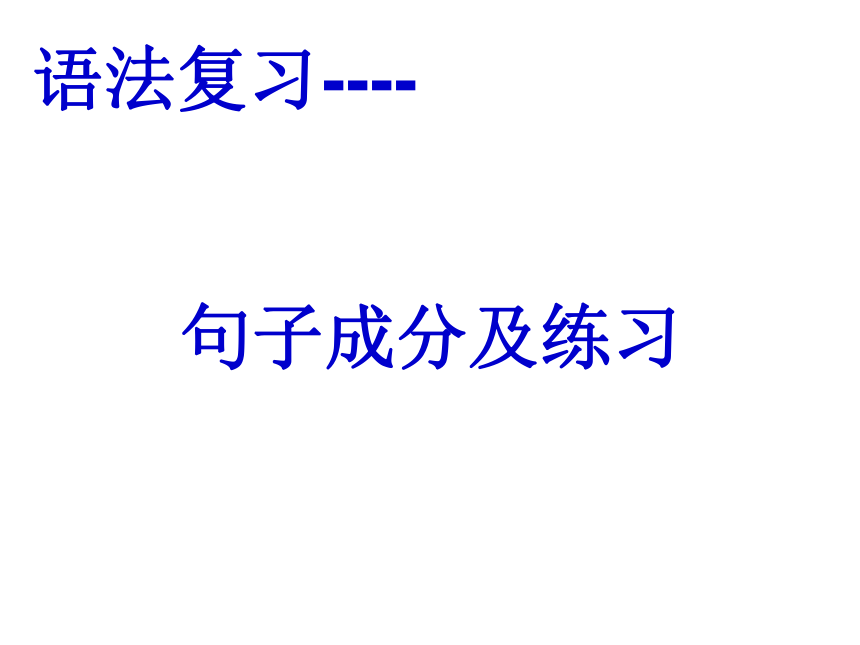 | |
| 格式 | zip | ||
| 文件大小 | 2.1MB | ||
| 资源类型 | 教案 | ||
| 版本资源 | 人教新目标(Go for it)版 | ||
| 科目 | 英语 | ||
| 更新时间 | 2023-02-08 19:00:34 | ||
图片预览

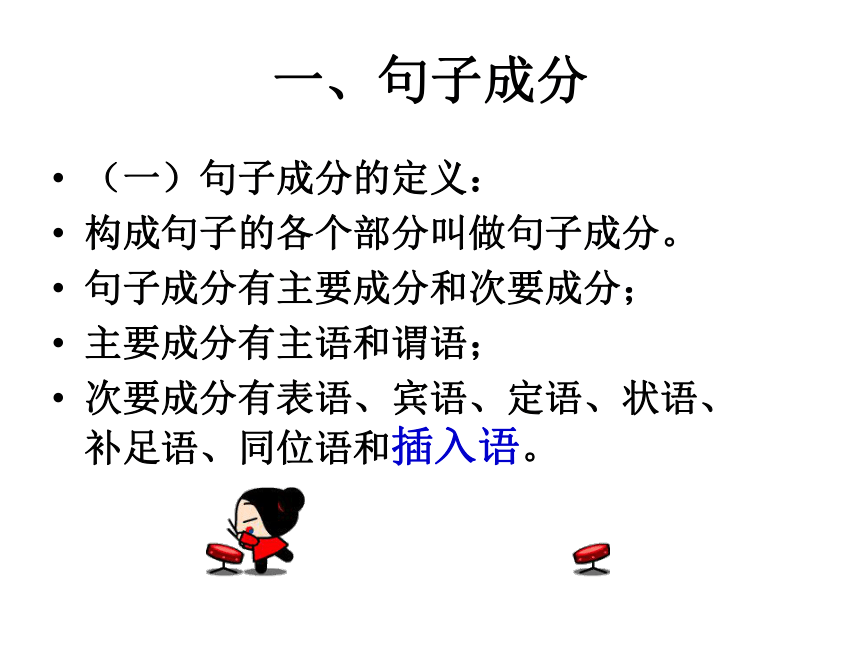
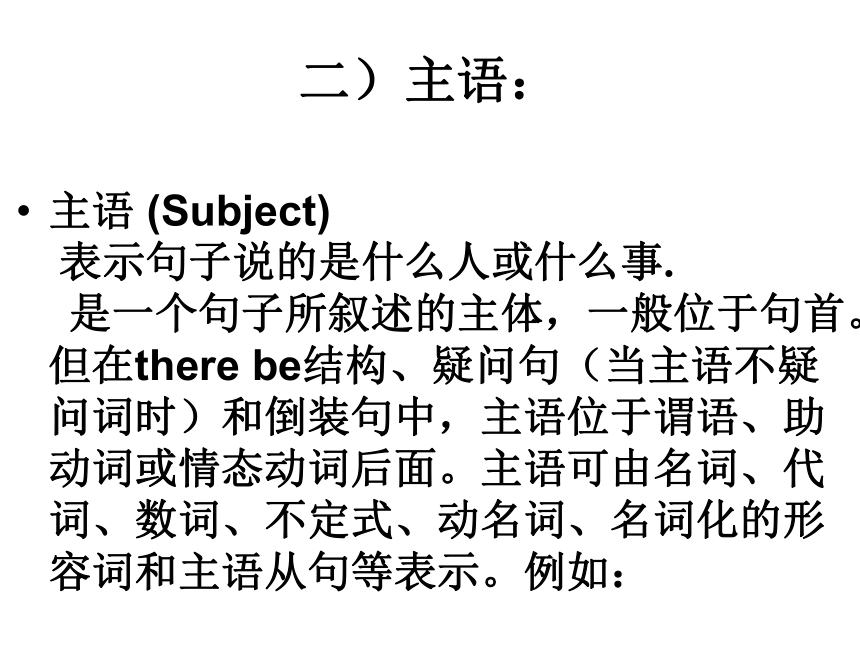
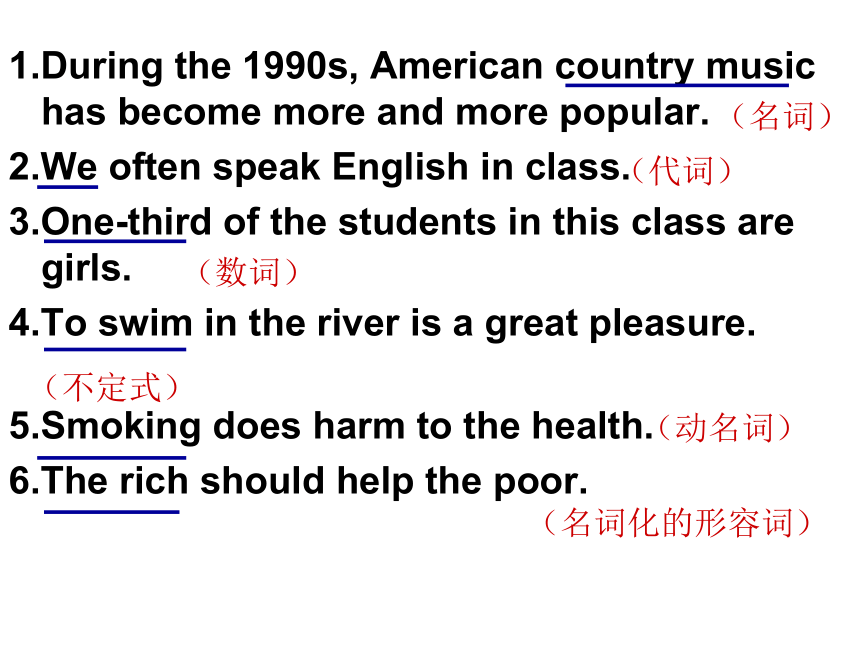
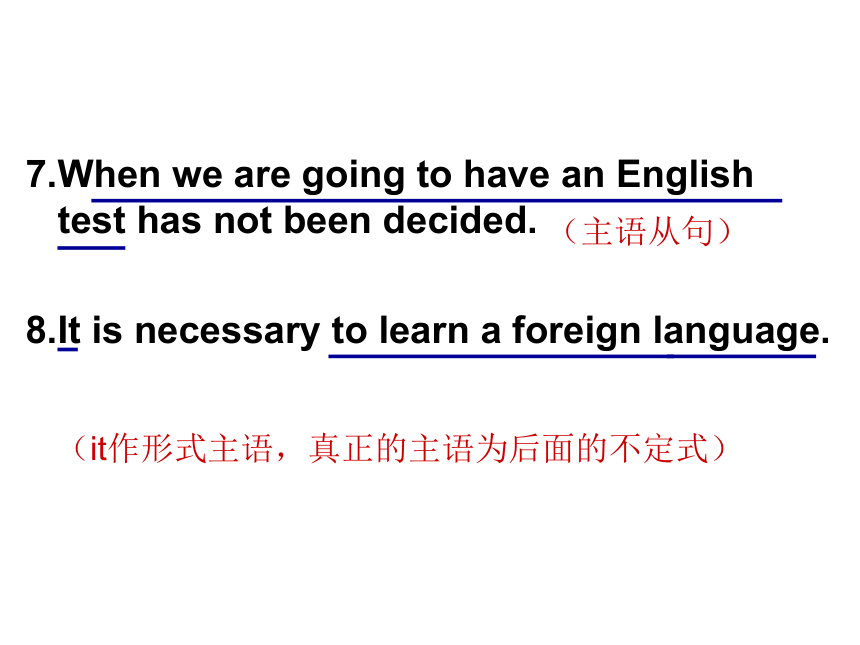
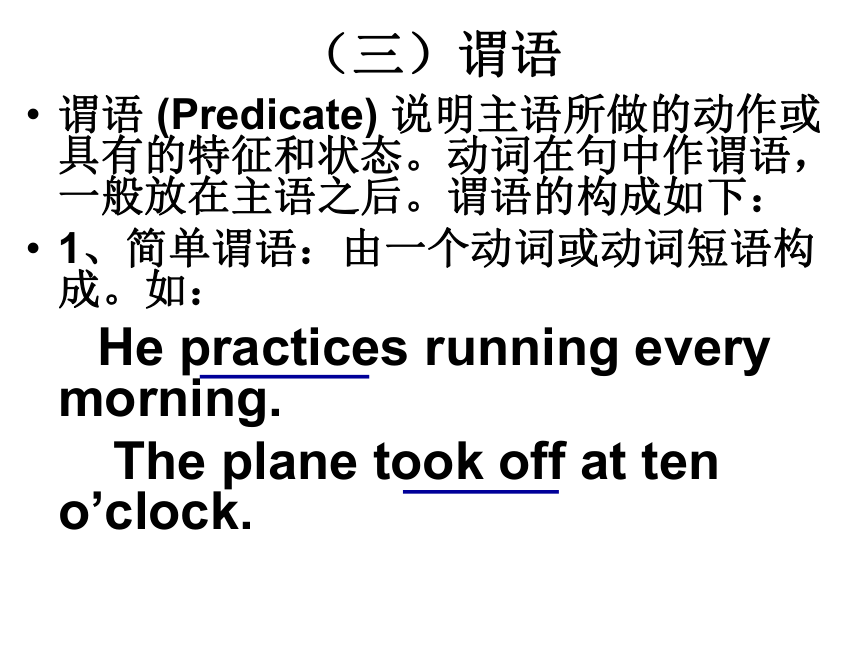
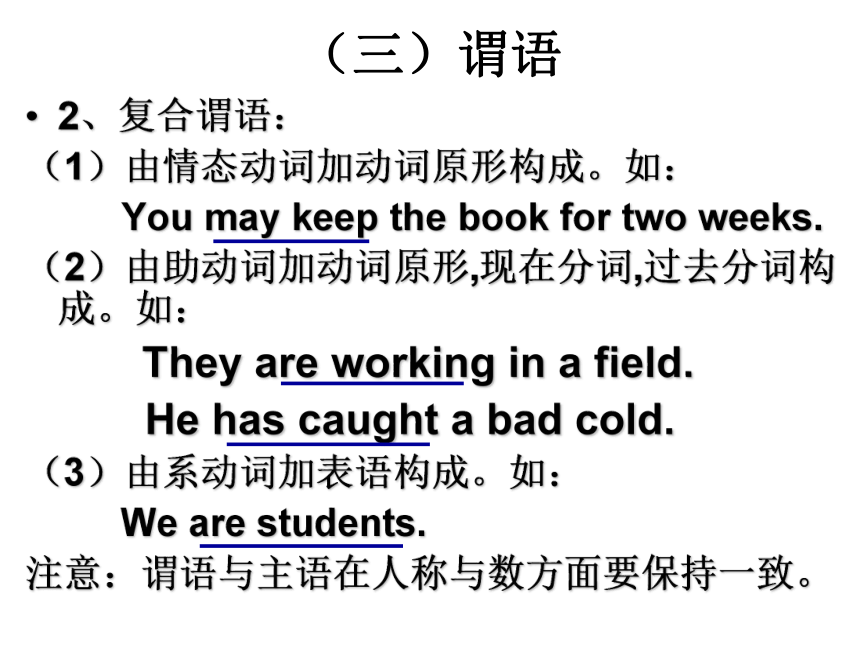
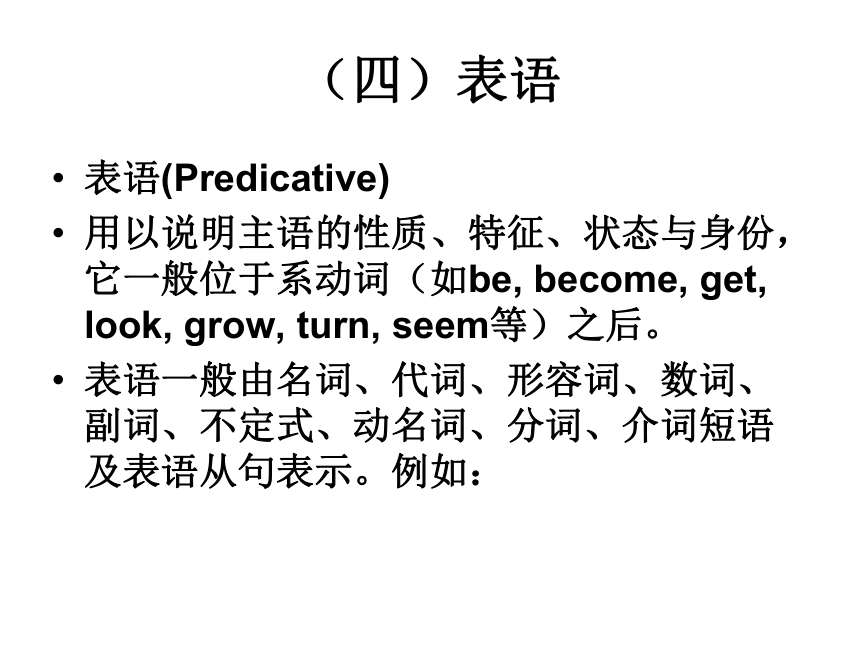
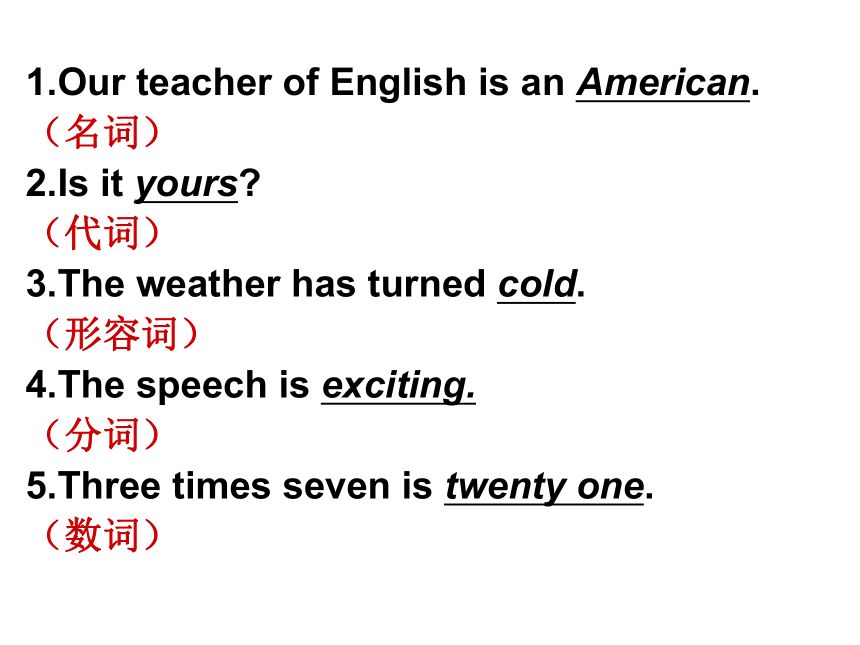
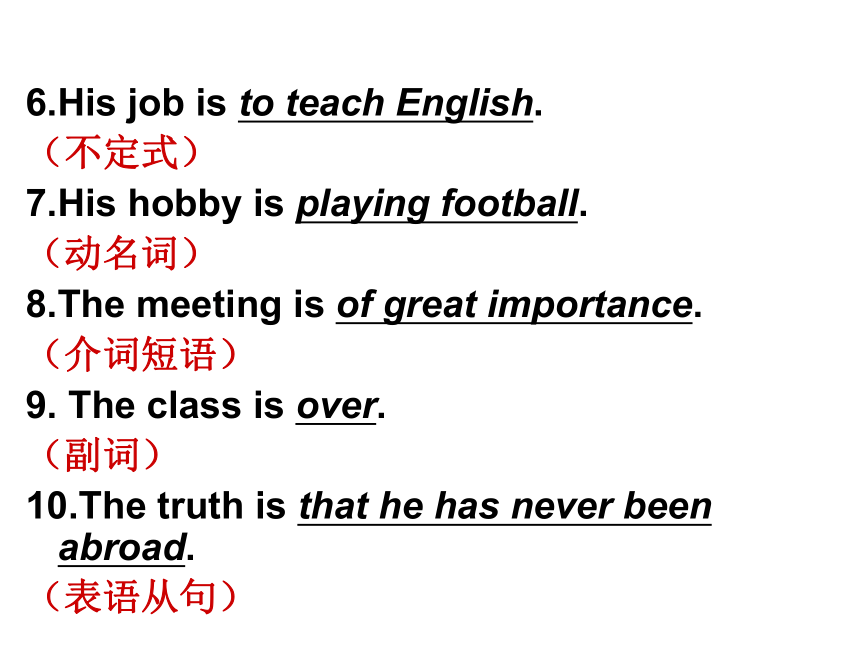
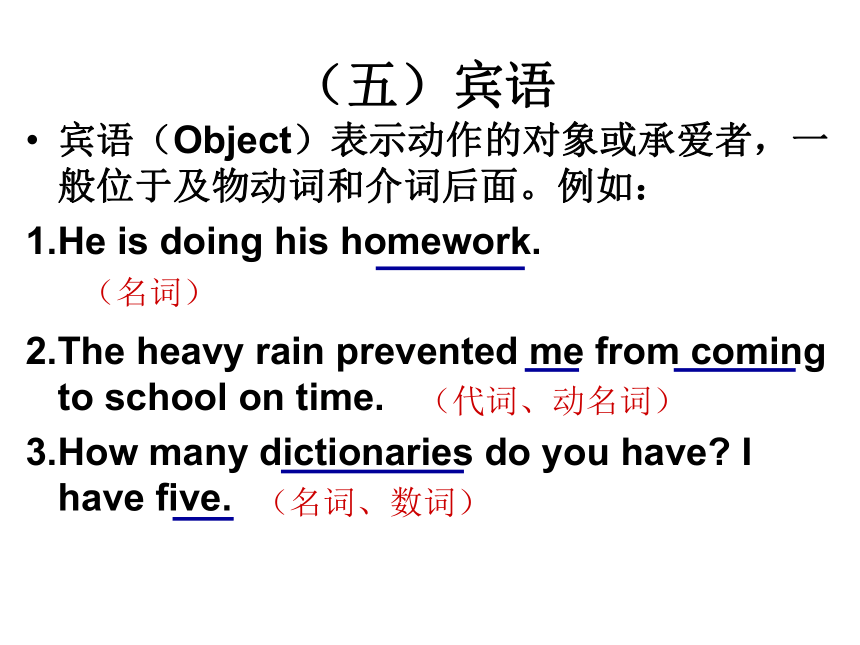
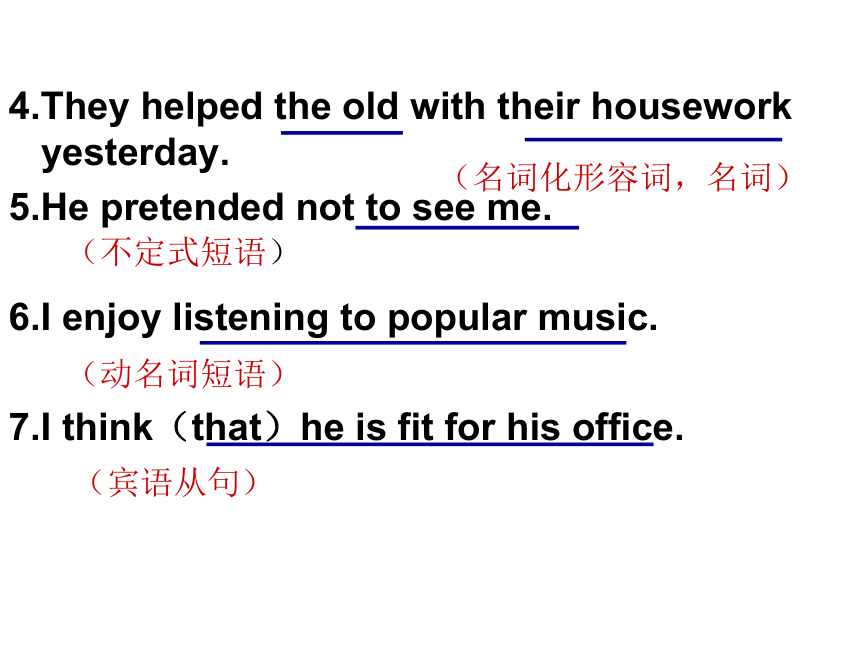
文档简介
(共62张PPT)
语法复习----
句子成分及练习
一、句子成分
(一)句子成分的定义:
构成句子的各个部分叫做句子成分。
句子成分有主要成分和次要成分;
主要成分有主语和谓语;
次要成分有表语、宾语、定语、状语、补足语、同位语和插入语。
二)主语:
主语 (Subject)
表示句子说的是什么人或什么事.
是一个句子所叙述的主体,一般位于句首。但在there be结构、疑问句(当主语不疑问词时)和倒装句中,主语位于谓语、助动词或情态动词后面。主语可由名词、代词、数词、不定式、动名词、名词化的形容词和主语从句等表示。例如:
1.During the 1990s, American country music has become more and more popular.
2.We often speak English in class.
3.One-third of the students in this class are girls.
4.To swim in the river is a great pleasure.
5.Smoking does harm to the health.
6.The rich should help the poor.
(名词)
(代词)
(数词)
(不定式)
(动名词)
(名词化的形容词)
7.When we are going to have an English test has not been decided.
8.It is necessary to learn a foreign language.
(主语从句)
(it作形式主语,真正的主语为后面的不定式)
(三)谓语
谓语 (Predicate) 说明主语所做的动作或具有的特征和状态。动词在句中作谓语,一般放在主语之后。谓语的构成如下:
1、简单谓语:由一个动词或动词短语构成。如:
He practices running every morning.
The plane took off at ten o’clock.
(三)谓语
2、复合谓语:
(1)由情态动词加动词原形构成。如:
You may keep the book for two weeks.
(2)由助动词加动词原形,现在分词,过去分词构成。如:
They are working in a field.
He has caught a bad cold.
(3)由系动词加表语构成。如:
We are students.
注意:谓语与主语在人称与数方面要保持一致。
(四)表语
表语(Predicative)
用以说明主语的性质、特征、状态与身份,它一般位于系动词(如be, become, get, look, grow, turn, seem等)之后。
表语一般由名词、代词、形容词、数词、 副词、不定式、动名词、分词、介词短语及表语从句表示。例如:
1.Our teacher of English is an American.
(名词)
2.Is it yours
(代词)
3.The weather has turned cold.
(形容词)
4.The speech is exciting.
(分词)
5.Three times seven is twenty one.
(数词)
6.His job is to teach English.
(不定式)
7.His hobby is playing football.
(动名词)
8.The meeting is of great importance.
(介词短语)
9. The class is over.
(副词)
10.The truth is that he has never been abroad.
(表语从句)
(五)宾语
宾语(Object)表示动作的对象或承爱者,一般位于及物动词和介词后面。例如:
1.He is doing his homework.
2.The heavy rain prevented me from coming to school on time.
3.How many dictionaries do you have I have five.
(名词)
(代词、动名词)
(名词、数词)
4.They helped the old with their housework yesterday.
5.He pretended not to see me.
6.I enjoy listening to popular music.
7.I think(that)he is fit for his office.
(名词化形容词,名词)
(不定式短语)
(动名词短语)
(宾语从句)
宾语种类:
(1)双宾语(间接宾语sb.+直接宾语sth.),例如:Lend me your dictionary,please.
=Lend your dictionary to me,please.
To: write, tell, pass, give, send, promise, show, hand, read, tell, bring, throw等,例如:
He sent the novel to William yesterday.
For: leave, buy, build, choose, cook, draw, make, find, get, order, post, 等,例如:
She bought a gift for her mother.
(2)复合 宾语(宾语+宾补),例如:
They chose him their monitor.
下列动词只能接不定式做宾语
ask, agree, care, choose,, dare, decide, expect, fail, help, hope, learn, manage, offer, plan, prepare, pretend, promise, refuse, want, wish, 等,如:
He refused to lend me his bike.
下列动词只能接动名词做宾语
admit ,avoid, advise, consider, enjoy, finish, imagine, mind, practise, suggest等,如:
John has admitted breaking the window .
下列动词既可接不定式,也可接动名词做宾语,但意义不同,如mean, try, remember, forget 等。
forget to do表示“未发生的动作”,forget doing表示“已完成的动作”。如:
Don't forget to come here earlier tomorrow.(还没来)
I forgot returning the book to him.
(书已还给他了)
(六)宾语补足语
宾语补足语(Object Complement),用于补充说明宾语的动作,一般位于宾语之后,宾语与宾语补足语一起构成复合宾语。需接复合宾语的动词有:tell,let,help,teach, ask,see,have,order,make等。“宾补”一般可由名词、形容词、副词、不定式、分词、介词短语和从句充当。例如:
1.His father named him Xiaoming.
2.They painted their boat white.
3.Let the fresh air in.
4.You mustn’t force him to lend his money to you.
5.We saw her entering the room.
(名词)
(形容词)
(副词)
(不定式短语)
(现在分词)
(七)定语
修饰名词或代词的词、短语或从句称为定语(Attribute)。
定语可由以下成分表示:
1.Guilin is a beautiful city.(形容词)
2.China is a developing country; America is a developed country.(分词)
3.There are thirty women teachers in our school.(名词)
4.His progress in English made us surprised.(代词)
5.Our monitor is always the first to enter the classroom.
(不定式短语)
6.The teaching plan for next term has been worked out.
(动名词)
7.He is reading an article about how to learn English.
(介词短语)
8.She is the girl who sings best in my class.
(定语从句)
说明1:当定语修饰不定代词如:nothing , anything , everything , something 等时,定语要放在其后作后置定语
我告诉他一些有趣的事情。
I tell him something interesting .
说明2:不定式、短语或从句作定语时,也放在被修饰的名词之后。
这间屋子里的男孩子们是10班的。
The boys in the room are in Class Ten.
(八)状语
修饰动词、形容词、副词或整个句子,说明动作或状态特征的句子成分,叫做状语(Adverbial)。可由以下形式表示 :
1.Light travels most quickly.
2.He has lived in the city for ten years.
3.He is proud to have passed the exam.
(副词及副词性词组)
(介词短语)
(不定式短语)
4.He is in the room making a model plane.
5.Wait a minute.
6.Once you begin, you must continue.
(分词短语)
(名词)
(状语从句)
9种状语种类如下:
1. How about meeting again at six
2.Last night she didn’t go to the dance party because of the rain.
3.I shall go there if it doesn’t rain.
4.Mr Smith lives on the third floor.
5.She put the eggs into the basket with great care.
(时间状语)
(原因状语)
(条件状语)
(地点状语)
(方式状语)
She came in with a dictionary in her hand.
6.In order to catch up with the others, I must work harder.
7.He was so tired that he fell asleep immediately.
8.She works very hard though she is old.
9.I am taller than he is.
(伴随状语)
(目的状语)
(结果状语)
(让步状语)
(比较状语)
(九)同位语(Appositive)对前面的名词或代词做进一步的解释,通常由名词、数词、代词或从句担任,如:
This is Mr. Zhou, our headmaster.
(十)插入语(Parenthesis)对一句话做一些附加的解释,通常有to be honest , I think (suppose, believe---)等,如:
To be honest, I don’t quite agree with you.
(定语从句)
概念: 在复合句中修饰名词或代词的句子.
She is the only one who’s studying French.
句子作定语,修饰代词one
He is a teacher who/ that teaches us Chinese.
句子作定语,修饰名词a teacher
先行词
关系词
定语从句
Mary is a girl who has long hair.
关系代词
关系副词
who, whom, whose, which, that
where, when, why
被定语从句修饰的名词或代词叫先行词。
定语从句一般放在先行词后面。
2. 引导定语从句的词叫关系词,在句中做句子成分。
关系代词在从句中充当主语、宾语、定语等成分,关系副词在句中作状语。
关系词的作用:
1. 引导一个定语从句;
2. 在从句中代替先行词;
3. 在从句中担任某一句子成份。
Mary is a girl.
A girl has long hair.
Mary is a girl
who has long hair.
I like music that / which I can dance to.
先行词
关系代词
定语从句
I like the singer who is beautiful.
I like the movie that is funny.
I still remember the first time when I met her.
定语从句构成:先行词+关系词+从句
关系词
关系代词:that, which, who, whom, whose
关系副词: when, where, why
关系代词:
指物:that which whose(所有格)
指人:who (主/宾格) that whom(宾格)
whose(所有格)
The boys who are playing football
are from Class One.
The man whom they wanted to visit
is a scientist.
1. who指人, 在从句中做主语(不能省) 或宾语(常可省略)
2. whom指人, 在从句中充当宾语(常可省)
who, whom, which, that ,whose, 用法区别.
The boy who they are talking about is Li Lei.
1) Football is a game which is liked by
most boys.
3. which指物,在定语从句中做主语
或者宾语,做宾语时可省略
主语,不能省
2) This is the pen (which) he bought
yesterday.
宾语,可省
4. that指人时, 相当于who或whom; 指
物时, 相当于which。 在定语从句中
做主语或者宾语,做宾语时可省略。
The girl (who/whom/that) we saw
yesterday is Anna.
2) A plane is a machine that/which
can fly.
1. He has a friend whose father is a doctor.
2. I have bought a house whose windows
face south.
5. whose通常指人, 也可指物, 在定语
从句中做定语
3. Please pass me the book whose cover
is green.
定语从句关系代词的用法:
1)当先行词是物时, 用which/that引导.
These are the trees which/that were
planted last year.
2)当先行词是人时, 用who/that/whom引导.
Mary is a girl who/that has long hair.
that既可以指人又可以指物
who/that/which在定语从句中做主语时,谓语动词的单复数应与先行词保持一致。
1) I prefer shoes that are cool.
2) I like a pizza that is really delicious.
3) I love singers who are beautiful.
4) I have a friend who plays sports.
This is the teacher _________ will go
to the south with us tomorrow.
(2) Is that the student ______________ the
teacher is talking with
(3) I like the present _________ you’ve sent
to me.
(4) The nurse _______________ we talked
about can speak English well.
(5) This is the job ___________ we’ve never
done before.
who/that
who/that/whom
that/which
who/that/whom
that/which
(6) This is the man ________________I met
yesterday.
( 7) This is the bag ___________ my mother
bought yesterday.
(8) The man _________ lives next to us is
my English teacher.
(9) The girl ______________ you saw in the
street is Mary.
who/that/whom
that/which
who/that
who/that/whom
定语从句关系副词的用法:
1、where指地点,在从句中充当地点状语。
This is the place where (in which) we lived
ten years ago.
2、 when指时间,在从句中充当时间状语。
He told me the date when(on which) he
joined the Party.
3、why指原因,在定语从句中充当原因状语。
I know the reason why(for which) she was
so angry.
关系副词when, where和关系代词that, which的区别:
同样是修饰一个地点,有时使用where, 有时使用that/which;同样是修饰一个时间,有时使用when, 有时使用that/which。这主要看两点:
一:先行词在定语从句中所作成分;
二:定语从句中的谓语动词是否 一个及物动词。
1.This is the park (that )we visited last
year.
This is the park where we held a birthday party.
2. She won’t forget the days (that) she spent on the island.
She won’t forget the days when they stayed together.
This is the place where you worked.
This is the place which/that you visited.
1)还原后为: you worked in the place,
Work为不及物动词,先行词the place做状语,所以用副词where作状语。
2)还原后为: you visited the place,
visit为及物动词,先行词the place 做visited的宾语,所以用代词which/that做宾语。
关系副词可转化为介词+which结构。
1) This is the house ______ once Lu Xun lived .
This is the house __________ once Lu Xun lived in.这就是鲁迅曾经住过的房子。
= in which
where
which/that
2) Beijing is the place ________ I was
born.
Beijing is the place _________ I was born in.
北京是我出生的地方。
= in which
where
which/that
A. where B. which C. whom D. whose
1) This is the factory ____ I visited last year.
2) This is the factory ____ I worked last year.
3) This is the factory _____ produces all kinds of TV sets.
B
A
B
3. Can you lend me the novel _____ the other day
A. that you talked B. you talked about it
C. which you talked with
D. you talked about
D
2. He has a friend _______ father is a doctor.
whose
She is the girl _________ talked with me yesterday.
who/that
A. where B. which C. whom D. whose
The place ____ interests the children most is the Children's Palace. A. what B. that C. where D. in which
2. The mountain ____ we visited last summer is the highest mountain in Europe. A. where B. on which C. what D. which
3. This is the park ____ I visited last week. A. which B. when C. what D. where
B
D
A
1) 先行词既有人又有物时;
只用that不用which
2) 先行词前面有最高级或序数词修饰时;
① He is the first person that passed the exam.
② He is the hardest man (that) I have ever met.
The film star (人) and her film (物) that you
have just talked about is well-known.
3) 当先行词前面有the only, the same,
the last, the very时;
The only thing (that) I want to do is to have a rest.
5. 当先行词是anything, everything, nothing ,few, all, none, little, the one 等不定代词,或者是由every, any, all, some, no, little, few, much 等修饰时;
4.在who, which引导的特殊疑问句中, 定语从句
中避免重复,一般也只用that.
1) Who is the man that is standing there 2) Which is the T-shirt that fits me most
I mean the one ____ you talked about just now.
Is there anything ________ you don’t know
I want to read all the books ________ were
written by Lu Xun.
that
that
that
注:
当one, ones, anybody, anyone, all, none, those, he, they, that, you 等作先行词时( 指人)一般用who,不用that.
Those who want to go to the cinema will have to wait at the gate of the school.
想去看电影的人必须在校门口等。
He who doesn't reach the Great Wall is not a real/true man.
小结:
that- 既可指人,也可指物,作主语,不能省略;作宾语,可以省略。
which-指物,作主语,不能省略;作宾语,可以省略。
who- 指人,作主语,不能省略;作宾语,可以省略,(常用whom)。
whose - 既可指人,也可指物 ,不能省略,作定语。
注:当关系代词在定语从句中作主语时,定语从句的谓语动词形式由先行词决定。
Exercise 1 :用关系代词填空
The boy ____________ is playing ping-pong is my classmate.
The e-mail ___________ I received yesterday was from my sister.
I hate people ______________ talk much but do little.
The car _____________ my father bought last month is very beautiful.
who / that
which/ that
who / that
which / that
5. The man ______ hair is white is his grandfather.
6. Is there a student _________ father is a business man
7. This is the house in ________ we have lived for 10 years.
8.I’ve never heard of the people and things ________ you talked about just now.
whose
whose
which
that
9. The man ______ leg broke in a match used to be a football player.
10.Is there anything ______ I can do for you
11. I have a friend ________ likes listening to classical music.
12. This is the best novel _______ I have read.
13.Who is the girl _______is standing under the tree
whose
that
that
that
that/who
14.Have you read the book _____ is about the moon
A. what B. it C. / D. which
15.The policeman caught the thief ______ has stolen Mr. Li’s computer.
A. which B. whose C. whom D. who
16.Tony, tell me the result of the discussion_____ you had with your dad yesterday.
A. what B. which C. when D. who
D
B
D
17.This is the camera ______my uncle gave me for my birthday.
A. which B. who C. what D.whose
18.—Where did you go last week
—I went to Zhang Aiping’s hometown and visited the house he was born in.
A. that B. there C. who D. whose
19.—Where did you go last week
—I went to Zhang Aiping’s hometown and visited the house he was born。
A. that B. where C. who D. whose
A
B
A
20. Is that the man_______ helped us a lot after the earthquake
which B. who C. whom D. there
21.We don't like people ____ talk too much but never do anything.
A. whose B. who C. when D. which
B
B
22.–Do you know the boy ___ is standing under the tree
-- Yes, he is my friend, Peter.
A. what B. who C. whom D. whose
23.Mary Smith says she likes to have friends_________ are different from her.
A. whose B. which C. who D. when
24.Do you know the girl _________ is singing in the classroom
A. when B. who C. which D. where
B
C
B
中考实战演习
1.Did the woman _____ wears thick glasses work in this school before
A. she B. her C. which D. that
2.I know there are many people there _____ speak English.
A. what B. who C. whose D. where
3.Many people enjoy the book Harry Potter _____by JK Rowling.
A. who writes B. which was written
C. was written D. which is writing
D
B
B
4.I like to live in a house_____ is big and bright.
A. that B. who C. how D. why
5.The money will be used to help the people _____ lost their homes in the earthquake.
A. who B. whose C. which D. where
6.I like the musician _____ different kinds of music.
A. that play B. who play
C. which play D. who plays
A
A
D
7.---Do you know the lady _____ is in blue
---Yes. She is a teacher of our university.
A. whom B. who C. which D. she
8.---What do you think of this story
---It’s too scary. I like the stories _____ make me feel excited.
A. who B. that they C. those D. that
9.The boy ____ is sitting near the window is called Sam.
A. who B. whose C. which D. whom
10.This is _____ I wanted .
A. the one what B. which C. one which D. the one
B
D
A
D
语法复习----
句子成分及练习
一、句子成分
(一)句子成分的定义:
构成句子的各个部分叫做句子成分。
句子成分有主要成分和次要成分;
主要成分有主语和谓语;
次要成分有表语、宾语、定语、状语、补足语、同位语和插入语。
二)主语:
主语 (Subject)
表示句子说的是什么人或什么事.
是一个句子所叙述的主体,一般位于句首。但在there be结构、疑问句(当主语不疑问词时)和倒装句中,主语位于谓语、助动词或情态动词后面。主语可由名词、代词、数词、不定式、动名词、名词化的形容词和主语从句等表示。例如:
1.During the 1990s, American country music has become more and more popular.
2.We often speak English in class.
3.One-third of the students in this class are girls.
4.To swim in the river is a great pleasure.
5.Smoking does harm to the health.
6.The rich should help the poor.
(名词)
(代词)
(数词)
(不定式)
(动名词)
(名词化的形容词)
7.When we are going to have an English test has not been decided.
8.It is necessary to learn a foreign language.
(主语从句)
(it作形式主语,真正的主语为后面的不定式)
(三)谓语
谓语 (Predicate) 说明主语所做的动作或具有的特征和状态。动词在句中作谓语,一般放在主语之后。谓语的构成如下:
1、简单谓语:由一个动词或动词短语构成。如:
He practices running every morning.
The plane took off at ten o’clock.
(三)谓语
2、复合谓语:
(1)由情态动词加动词原形构成。如:
You may keep the book for two weeks.
(2)由助动词加动词原形,现在分词,过去分词构成。如:
They are working in a field.
He has caught a bad cold.
(3)由系动词加表语构成。如:
We are students.
注意:谓语与主语在人称与数方面要保持一致。
(四)表语
表语(Predicative)
用以说明主语的性质、特征、状态与身份,它一般位于系动词(如be, become, get, look, grow, turn, seem等)之后。
表语一般由名词、代词、形容词、数词、 副词、不定式、动名词、分词、介词短语及表语从句表示。例如:
1.Our teacher of English is an American.
(名词)
2.Is it yours
(代词)
3.The weather has turned cold.
(形容词)
4.The speech is exciting.
(分词)
5.Three times seven is twenty one.
(数词)
6.His job is to teach English.
(不定式)
7.His hobby is playing football.
(动名词)
8.The meeting is of great importance.
(介词短语)
9. The class is over.
(副词)
10.The truth is that he has never been abroad.
(表语从句)
(五)宾语
宾语(Object)表示动作的对象或承爱者,一般位于及物动词和介词后面。例如:
1.He is doing his homework.
2.The heavy rain prevented me from coming to school on time.
3.How many dictionaries do you have I have five.
(名词)
(代词、动名词)
(名词、数词)
4.They helped the old with their housework yesterday.
5.He pretended not to see me.
6.I enjoy listening to popular music.
7.I think(that)he is fit for his office.
(名词化形容词,名词)
(不定式短语)
(动名词短语)
(宾语从句)
宾语种类:
(1)双宾语(间接宾语sb.+直接宾语sth.),例如:Lend me your dictionary,please.
=Lend your dictionary to me,please.
To: write, tell, pass, give, send, promise, show, hand, read, tell, bring, throw等,例如:
He sent the novel to William yesterday.
For: leave, buy, build, choose, cook, draw, make, find, get, order, post, 等,例如:
She bought a gift for her mother.
(2)复合 宾语(宾语+宾补),例如:
They chose him their monitor.
下列动词只能接不定式做宾语
ask, agree, care, choose,, dare, decide, expect, fail, help, hope, learn, manage, offer, plan, prepare, pretend, promise, refuse, want, wish, 等,如:
He refused to lend me his bike.
下列动词只能接动名词做宾语
admit ,avoid, advise, consider, enjoy, finish, imagine, mind, practise, suggest等,如:
John has admitted breaking the window .
下列动词既可接不定式,也可接动名词做宾语,但意义不同,如mean, try, remember, forget 等。
forget to do表示“未发生的动作”,forget doing表示“已完成的动作”。如:
Don't forget to come here earlier tomorrow.(还没来)
I forgot returning the book to him.
(书已还给他了)
(六)宾语补足语
宾语补足语(Object Complement),用于补充说明宾语的动作,一般位于宾语之后,宾语与宾语补足语一起构成复合宾语。需接复合宾语的动词有:tell,let,help,teach, ask,see,have,order,make等。“宾补”一般可由名词、形容词、副词、不定式、分词、介词短语和从句充当。例如:
1.His father named him Xiaoming.
2.They painted their boat white.
3.Let the fresh air in.
4.You mustn’t force him to lend his money to you.
5.We saw her entering the room.
(名词)
(形容词)
(副词)
(不定式短语)
(现在分词)
(七)定语
修饰名词或代词的词、短语或从句称为定语(Attribute)。
定语可由以下成分表示:
1.Guilin is a beautiful city.(形容词)
2.China is a developing country; America is a developed country.(分词)
3.There are thirty women teachers in our school.(名词)
4.His progress in English made us surprised.(代词)
5.Our monitor is always the first to enter the classroom.
(不定式短语)
6.The teaching plan for next term has been worked out.
(动名词)
7.He is reading an article about how to learn English.
(介词短语)
8.She is the girl who sings best in my class.
(定语从句)
说明1:当定语修饰不定代词如:nothing , anything , everything , something 等时,定语要放在其后作后置定语
我告诉他一些有趣的事情。
I tell him something interesting .
说明2:不定式、短语或从句作定语时,也放在被修饰的名词之后。
这间屋子里的男孩子们是10班的。
The boys in the room are in Class Ten.
(八)状语
修饰动词、形容词、副词或整个句子,说明动作或状态特征的句子成分,叫做状语(Adverbial)。可由以下形式表示 :
1.Light travels most quickly.
2.He has lived in the city for ten years.
3.He is proud to have passed the exam.
(副词及副词性词组)
(介词短语)
(不定式短语)
4.He is in the room making a model plane.
5.Wait a minute.
6.Once you begin, you must continue.
(分词短语)
(名词)
(状语从句)
9种状语种类如下:
1. How about meeting again at six
2.Last night she didn’t go to the dance party because of the rain.
3.I shall go there if it doesn’t rain.
4.Mr Smith lives on the third floor.
5.She put the eggs into the basket with great care.
(时间状语)
(原因状语)
(条件状语)
(地点状语)
(方式状语)
She came in with a dictionary in her hand.
6.In order to catch up with the others, I must work harder.
7.He was so tired that he fell asleep immediately.
8.She works very hard though she is old.
9.I am taller than he is.
(伴随状语)
(目的状语)
(结果状语)
(让步状语)
(比较状语)
(九)同位语(Appositive)对前面的名词或代词做进一步的解释,通常由名词、数词、代词或从句担任,如:
This is Mr. Zhou, our headmaster.
(十)插入语(Parenthesis)对一句话做一些附加的解释,通常有to be honest , I think (suppose, believe---)等,如:
To be honest, I don’t quite agree with you.
(定语从句)
概念: 在复合句中修饰名词或代词的句子.
She is the only one who’s studying French.
句子作定语,修饰代词one
He is a teacher who/ that teaches us Chinese.
句子作定语,修饰名词a teacher
先行词
关系词
定语从句
Mary is a girl who has long hair.
关系代词
关系副词
who, whom, whose, which, that
where, when, why
被定语从句修饰的名词或代词叫先行词。
定语从句一般放在先行词后面。
2. 引导定语从句的词叫关系词,在句中做句子成分。
关系代词在从句中充当主语、宾语、定语等成分,关系副词在句中作状语。
关系词的作用:
1. 引导一个定语从句;
2. 在从句中代替先行词;
3. 在从句中担任某一句子成份。
Mary is a girl.
A girl has long hair.
Mary is a girl
who has long hair.
I like music that / which I can dance to.
先行词
关系代词
定语从句
I like the singer who is beautiful.
I like the movie that is funny.
I still remember the first time when I met her.
定语从句构成:先行词+关系词+从句
关系词
关系代词:that, which, who, whom, whose
关系副词: when, where, why
关系代词:
指物:that which whose(所有格)
指人:who (主/宾格) that whom(宾格)
whose(所有格)
The boys who are playing football
are from Class One.
The man whom they wanted to visit
is a scientist.
1. who指人, 在从句中做主语(不能省) 或宾语(常可省略)
2. whom指人, 在从句中充当宾语(常可省)
who, whom, which, that ,whose, 用法区别.
The boy who they are talking about is Li Lei.
1) Football is a game which is liked by
most boys.
3. which指物,在定语从句中做主语
或者宾语,做宾语时可省略
主语,不能省
2) This is the pen (which) he bought
yesterday.
宾语,可省
4. that指人时, 相当于who或whom; 指
物时, 相当于which。 在定语从句中
做主语或者宾语,做宾语时可省略。
The girl (who/whom/that) we saw
yesterday is Anna.
2) A plane is a machine that/which
can fly.
1. He has a friend whose father is a doctor.
2. I have bought a house whose windows
face south.
5. whose通常指人, 也可指物, 在定语
从句中做定语
3. Please pass me the book whose cover
is green.
定语从句关系代词的用法:
1)当先行词是物时, 用which/that引导.
These are the trees which/that were
planted last year.
2)当先行词是人时, 用who/that/whom引导.
Mary is a girl who/that has long hair.
that既可以指人又可以指物
who/that/which在定语从句中做主语时,谓语动词的单复数应与先行词保持一致。
1) I prefer shoes that are cool.
2) I like a pizza that is really delicious.
3) I love singers who are beautiful.
4) I have a friend who plays sports.
This is the teacher _________ will go
to the south with us tomorrow.
(2) Is that the student ______________ the
teacher is talking with
(3) I like the present _________ you’ve sent
to me.
(4) The nurse _______________ we talked
about can speak English well.
(5) This is the job ___________ we’ve never
done before.
who/that
who/that/whom
that/which
who/that/whom
that/which
(6) This is the man ________________I met
yesterday.
( 7) This is the bag ___________ my mother
bought yesterday.
(8) The man _________ lives next to us is
my English teacher.
(9) The girl ______________ you saw in the
street is Mary.
who/that/whom
that/which
who/that
who/that/whom
定语从句关系副词的用法:
1、where指地点,在从句中充当地点状语。
This is the place where (in which) we lived
ten years ago.
2、 when指时间,在从句中充当时间状语。
He told me the date when(on which) he
joined the Party.
3、why指原因,在定语从句中充当原因状语。
I know the reason why(for which) she was
so angry.
关系副词when, where和关系代词that, which的区别:
同样是修饰一个地点,有时使用where, 有时使用that/which;同样是修饰一个时间,有时使用when, 有时使用that/which。这主要看两点:
一:先行词在定语从句中所作成分;
二:定语从句中的谓语动词是否 一个及物动词。
1.This is the park (that )we visited last
year.
This is the park where we held a birthday party.
2. She won’t forget the days (that) she spent on the island.
She won’t forget the days when they stayed together.
This is the place where you worked.
This is the place which/that you visited.
1)还原后为: you worked in the place,
Work为不及物动词,先行词the place做状语,所以用副词where作状语。
2)还原后为: you visited the place,
visit为及物动词,先行词the place 做visited的宾语,所以用代词which/that做宾语。
关系副词可转化为介词+which结构。
1) This is the house ______ once Lu Xun lived .
This is the house __________ once Lu Xun lived in.这就是鲁迅曾经住过的房子。
= in which
where
which/that
2) Beijing is the place ________ I was
born.
Beijing is the place _________ I was born in.
北京是我出生的地方。
= in which
where
which/that
A. where B. which C. whom D. whose
1) This is the factory ____ I visited last year.
2) This is the factory ____ I worked last year.
3) This is the factory _____ produces all kinds of TV sets.
B
A
B
3. Can you lend me the novel _____ the other day
A. that you talked B. you talked about it
C. which you talked with
D. you talked about
D
2. He has a friend _______ father is a doctor.
whose
She is the girl _________ talked with me yesterday.
who/that
A. where B. which C. whom D. whose
The place ____ interests the children most is the Children's Palace. A. what B. that C. where D. in which
2. The mountain ____ we visited last summer is the highest mountain in Europe. A. where B. on which C. what D. which
3. This is the park ____ I visited last week. A. which B. when C. what D. where
B
D
A
1) 先行词既有人又有物时;
只用that不用which
2) 先行词前面有最高级或序数词修饰时;
① He is the first person that passed the exam.
② He is the hardest man (that) I have ever met.
The film star (人) and her film (物) that you
have just talked about is well-known.
3) 当先行词前面有the only, the same,
the last, the very时;
The only thing (that) I want to do is to have a rest.
5. 当先行词是anything, everything, nothing ,few, all, none, little, the one 等不定代词,或者是由every, any, all, some, no, little, few, much 等修饰时;
4.在who, which引导的特殊疑问句中, 定语从句
中避免重复,一般也只用that.
1) Who is the man that is standing there 2) Which is the T-shirt that fits me most
I mean the one ____ you talked about just now.
Is there anything ________ you don’t know
I want to read all the books ________ were
written by Lu Xun.
that
that
that
注:
当one, ones, anybody, anyone, all, none, those, he, they, that, you 等作先行词时( 指人)一般用who,不用that.
Those who want to go to the cinema will have to wait at the gate of the school.
想去看电影的人必须在校门口等。
He who doesn't reach the Great Wall is not a real/true man.
小结:
that- 既可指人,也可指物,作主语,不能省略;作宾语,可以省略。
which-指物,作主语,不能省略;作宾语,可以省略。
who- 指人,作主语,不能省略;作宾语,可以省略,(常用whom)。
whose - 既可指人,也可指物 ,不能省略,作定语。
注:当关系代词在定语从句中作主语时,定语从句的谓语动词形式由先行词决定。
Exercise 1 :用关系代词填空
The boy ____________ is playing ping-pong is my classmate.
The e-mail ___________ I received yesterday was from my sister.
I hate people ______________ talk much but do little.
The car _____________ my father bought last month is very beautiful.
who / that
which/ that
who / that
which / that
5. The man ______ hair is white is his grandfather.
6. Is there a student _________ father is a business man
7. This is the house in ________ we have lived for 10 years.
8.I’ve never heard of the people and things ________ you talked about just now.
whose
whose
which
that
9. The man ______ leg broke in a match used to be a football player.
10.Is there anything ______ I can do for you
11. I have a friend ________ likes listening to classical music.
12. This is the best novel _______ I have read.
13.Who is the girl _______is standing under the tree
whose
that
that
that
that/who
14.Have you read the book _____ is about the moon
A. what B. it C. / D. which
15.The policeman caught the thief ______ has stolen Mr. Li’s computer.
A. which B. whose C. whom D. who
16.Tony, tell me the result of the discussion_____ you had with your dad yesterday.
A. what B. which C. when D. who
D
B
D
17.This is the camera ______my uncle gave me for my birthday.
A. which B. who C. what D.whose
18.—Where did you go last week
—I went to Zhang Aiping’s hometown and visited the house he was born in.
A. that B. there C. who D. whose
19.—Where did you go last week
—I went to Zhang Aiping’s hometown and visited the house he was born。
A. that B. where C. who D. whose
A
B
A
20. Is that the man_______ helped us a lot after the earthquake
which B. who C. whom D. there
21.We don't like people ____ talk too much but never do anything.
A. whose B. who C. when D. which
B
B
22.–Do you know the boy ___ is standing under the tree
-- Yes, he is my friend, Peter.
A. what B. who C. whom D. whose
23.Mary Smith says she likes to have friends_________ are different from her.
A. whose B. which C. who D. when
24.Do you know the girl _________ is singing in the classroom
A. when B. who C. which D. where
B
C
B
中考实战演习
1.Did the woman _____ wears thick glasses work in this school before
A. she B. her C. which D. that
2.I know there are many people there _____ speak English.
A. what B. who C. whose D. where
3.Many people enjoy the book Harry Potter _____by JK Rowling.
A. who writes B. which was written
C. was written D. which is writing
D
B
B
4.I like to live in a house_____ is big and bright.
A. that B. who C. how D. why
5.The money will be used to help the people _____ lost their homes in the earthquake.
A. who B. whose C. which D. where
6.I like the musician _____ different kinds of music.
A. that play B. who play
C. which play D. who plays
A
A
D
7.---Do you know the lady _____ is in blue
---Yes. She is a teacher of our university.
A. whom B. who C. which D. she
8.---What do you think of this story
---It’s too scary. I like the stories _____ make me feel excited.
A. who B. that they C. those D. that
9.The boy ____ is sitting near the window is called Sam.
A. who B. whose C. which D. whom
10.This is _____ I wanted .
A. the one what B. which C. one which D. the one
B
D
A
D
同课章节目录
